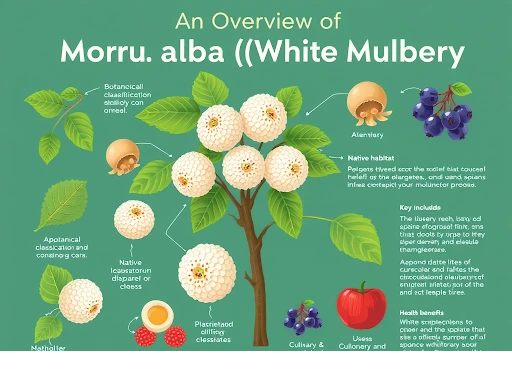An Introduction to White Mulberry
An Overview of Morus alba (White Mulberry)
White mulberry (Morus alba) is a shrub native to China that is grown extensively across Asia, Europe, and North America. Its most notable feature is its leaf which is the principal food for silkworms and is therefore, vital in silk production. This durable tree is found in different climates and has been important for its medicinal, dietary, and commercial uses.
Origin and Historical Significance
Like many plants, white mulberry has a rich history that begins in ancient China thousands of years ago where it was grown extensively for silk. The plant traveled and spread through trade routes like the Silk Road and into Europe and beyond. In native Chinese medicine, white mulberry was considered beneficial in treating fever, diabetes, inflammation, and other ailments. Its wonders are being researched around the globe even today.
Growing Characteristics and Botany Features
Despite white mulberries can reach a height of 60 feet, they are usually trimmed to more convenient sizes for harvesting fruits and leaves. Their root systems are robust, and they are fast-growing, so they are able to adapt to a variety of soil conditions. These trees have small, dense flowers that grow into small, edible berries which can be white or a deep purple color. Their broad, ovate, and wide leaves have varying shapes, making it easier to incorporate them to different processes.
Folio and Present-day Purposes
In the past, white mulberry leaves were helpful in making food, medicine, and textiles. Herbal uses of the plant now include dietary supplements, health tonics, and natural sweeteners. The tree’s leaves, bark, and berries are utilized when medicine is needed, while the wood is used in furniture and paper manufacturing.
Involvement in Regulation of Blood Sugar
Research indicates that the extract of white mulberry leaves may assist in the regulation of blood sugar levels by blocking the activity of the carbohydrate digesting enzymes. This action delays glucose metabolism and infusion, resulting in lower blood sugar levels after a meal. For this reason, white mulberry is frequently used as a dietary supplement for diabetes and insulin resistance management.
Cholesterol and Heart Health
White mulberry is reputed to enhance heart health by lowering the LDL (bad) cholesterol and increasing the HDL (good) cholesterol. The plant’s fiber is beneficial in digestion and regulation of cholesterol, while its antioxidant properties aid in the reduction of inflammation in blood vessels, which is important for cardiovascular health.
Supporting the Immune System
Due to mulberyy’s superior immune enhancing properties, it aids the body in support itself more vigorously. Its anti-inflammatory and antibacterial properties effectively fight against infection, while high vitamin C aids in immunity.
White Mulberry in Herbal Medicine
Ancient Medicinal Uses in China and Beyond
White mulberry has been used for high blood pressure, fever, and cough in traditional Chinese medicine (TCM). It was thought to improve lung function, circulate blood more effectively, and strengthen the liver. Even in ancient time medical practitioners made use of different portions of the white mulberry plant like the leaves, bark, and roots for their healing properties.
Modern Research on Its Healing Properties
Recent studies suggest that white mulberry may be useful for metabolic disorders or inflammation, addressing inflammation, and even microbial infections. Other research underlined its importance in treating obesity, heart diseases, and even neurodegenerative disorders such as Alzheimer’s. It has claimed therapeutic impacts due to the presence of bioactive compounds such as resveratrol and flavonoids.
Benefits for Digestion and Metabolism
White mulberry contains dietary fiber that aids digestion and promotes gut health. It normalizes the movement of the intestines, thereby minimizing cases of constipation and bloating. The plant’s natural compounds support metabolic function by promoting fat metabolism and aiding in weight management.
How It Supports Liver and Kidney Health
White mulberry helps in detoxification, which assists the liver and kidneys to clean themselves from toxic materials. This supports their function of filtering toxins from the body. In herbal medicine, it is used to enhance liver enzymes, decrease fatty liver signs and symptoms, and avert problems of the kidney.
Growing and Caring for White Mulberry Trees
Ideal Weather and Soil Requirements
The white mulberry tree does best in dry, temperate weather, but it can survive in a variety of climates. Ideal soil is well-draining and moderately moist, so sandy, loamy, and even clay-rich soil can be used. Growth is optimal with exposure to direct sunlight.
Best Practices for Planting and Watering
Propagating white mulberry trees is possible through seed, cuttings, or even grafts. When first planting, it is crucial to provide the tree with enough growth space. Young trees require consistent watering, but mature trees are much more resilient to dry spells. Soil moisture is able to be retained when the ground is covered with mulch, which also prevents weed growth.
Common Pests and Tree Diseases
While being a hardy tree, the white mulberry may experience spider mite, aphid, or scale insect infestations. In humid weather, the white mulberry tree can be affected by powdery mildew and root rot fungus infections. The best way to manage these problems is through organic pesticides and trimming of the leaves and branches. For more insights on sustainable plant care, visit ThinkNest, where you’ll find expert tips on organic gardening and tree maintenance.
Bark, berries, and leaf harvesting
Leaves are best harvested multiple times yearly to create tea or supplements. The white mulberry’s berries are edible when fresh or dried and ripen during late spring and early summer. Finally, the bark is harvested to create extracts for use in medicine and natural remedies.
Mulberry’s Role in Food and Industry
Culinary Aspects: Tea, Jam, and Additives
Because of its sweet flavor, white mulberry berries are used in several types of food products such as jams, juices, and baked goods. The leaves, on the other hand, are made into herbal tea which is known to have health benefits. For their therapeutic uses, supplements made from dried leaves and extracts are in great demand.
Use in Silk Production and Textile Industry
White mulberry has been historically important in silk production, which is its primary use. The leaves are the only source of food for silkworms that spin silk threads to the fabrics. The tree still has great significance in this industry in the silk producing areas.
Sustainability and Ecological Issues
Being fast growing and low maintenance makes white mulberry an environmentally friendly plant. Besides conserving soil, these trees shade, and increases biodiversity. Due to their ability to adapt to different climates, they make very environmentally friendly agriculture.
The Role in Future Agriculture and Medicine
Mulberry has several unexplored potentials in medicine and nutrition as interest in natural health boosters increase. Investigating its compounds could lead to new therapies for chronic diseases, and in combination with its adaptability, makes it a very important crop for sustainable agriculture.
The white mulberry, a plant with rich historical applications, is very useful today as well. This tree has been integral to contemporary and traditional industries, from silk production through to its multiple health benefits. From aiding as a dietary supplement to medicine, and even in farming, the white mulberry continues to be a resource for years to come.
Read also:White Mulberry: A Multifaceted Plant for Health Care Beauty, Economics, and Environmental Purposes


Leave a Reply